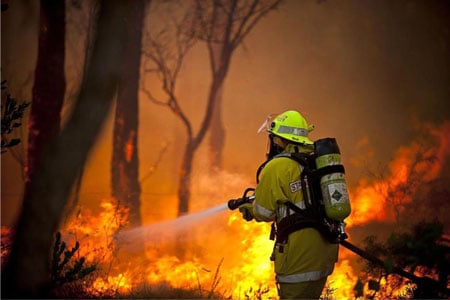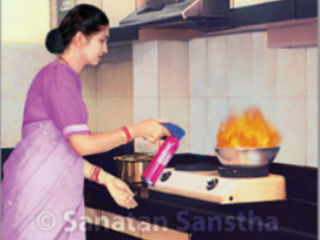
In our last Issue, we learnt about Components of fire, Common causes of fire, Classification of fires, What will you do when you see fire ?, Some techniques of firefighting. Now, read ahead.
A. Techniques of firefighting
1. Smothering
When the oxygen supply to a fire is cut off completely or the oxygen percentage in the air falls below 16%, the fire gets extinguished immediately. This can be proved in an experiment of covering a burning candle with a glass. This is referred to as ‘smothering’.
2. Breaking the chain reaction
Fire can be extinguished by breaking the chain reaction of burning using specific chemicals; for example, halon gas. However, since these are very expensive, their use is restricted to specific conditions.
B. Agents used in firefighting : The
functioning of these agents is given ahead
1. Water
Water sprayed continuously over burning wood, paper or other carbonaceous substances (Class ‘A’ fire) or metal (Class ‘D’ fire) absorbs heat from these burning substances. If the rate of absorption of heat is more than the rate of generation of heat, the fire gets extinguished.
2. Dry chemical powder
Chemical powders of sodium bicarbonate and potass-ium bicarbonate are called ‘dry chemical powder’. It is pure white in colour. When it is sprayed on a fire under pressure with the help of carbon dioxide, it forms a cloud of particles over the fire. This cloud breaks the contact of fire with the air, and because of insufficient oxygen and breakage in the burning chain, the fire gets extinguished. This is used mainly in extinguishing Class ‘B’ and ‘C’ fires and is useful in extinguish-ing fires in electrical appliances.
3. Carbon dioxide
This is stored under high pressure in liquid form in specially designed cylinders. Since it is five times heavier than air, when it is sprayed over fire it forms a layer on burning substances. In this way, since fire is prevented from coming in contact with air (oxygen), it gets extinguished. This is used mainly when electrical appliances catch fire.
4. Specific chemicals
Some chemicals break the chain reaction of burning and help in extinguishing fire. Such chemicals are used sparsely in firefighting.
5. Sand
If the fire is small and nothing else is available, sand proves to be effective in extinguishing Class ‘A’, ‘B’ and ‘D’ fires. If sand is not available, dry mud can be used.
Sanatan’s text on the subject of firefighting also elaborates on the use of mediums such as steam, asbestos cloth, foam and when to use which type of extinguisher.
C. Situations and remedial measures
As important as promptness in extinguishing a fire or even more important is the decision whether to combat a fire single-handedly. Given ahead are certain guidelines that will help in taking this decision. If the answer to any of these questions is ‘Yes’, do not attempt to extinguish the fire as it could be fatal; instead, move immediately to a safe place and call for help.
- Is the fire spreading rapidly from the site of its outbreak ?
- Is it impossible to extinguish the fire with your back to the path of escape ?
- Is the fire obstructing your only route of escape ?
- Are appropriate firefighting devices not available ?
- Have you exhausted all your fire-fighting mediums ?
- Are fire protection devices such as a fire suit not available ?
- Combustible materials
- Flammable liquids and gas
- Electrical appliances
- Electric materials
- Cooking appliances

 Practical training in firefighting
Practical training in firefighting Techniques of firefighting
Techniques of firefighting